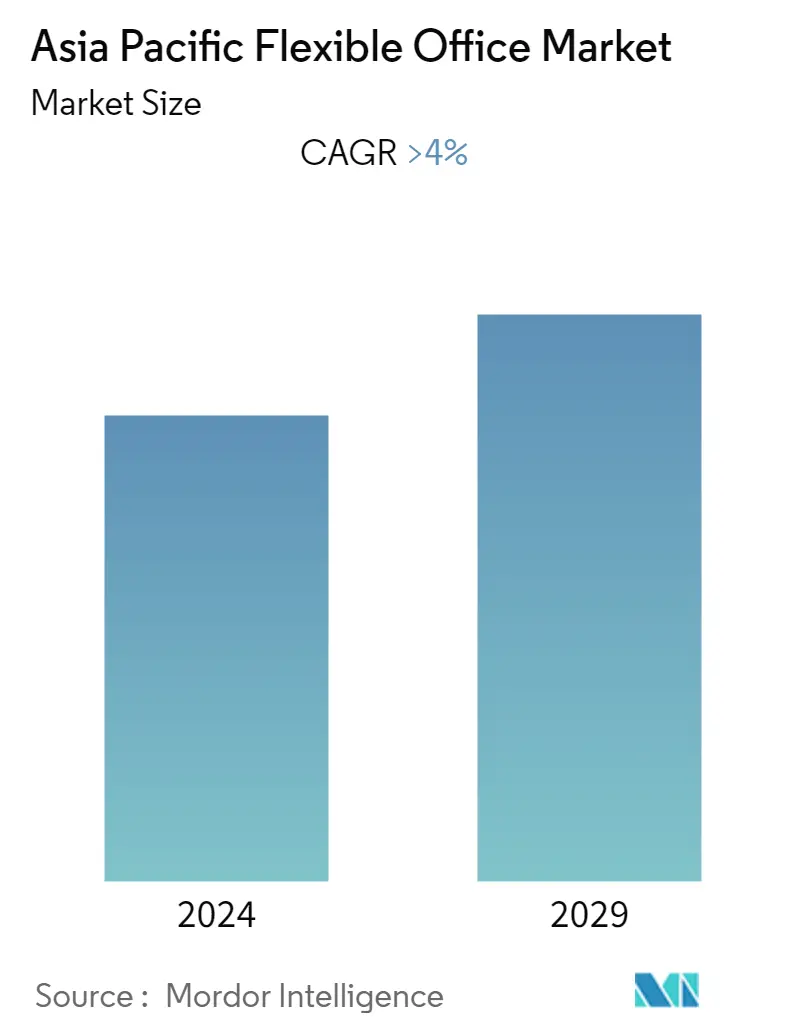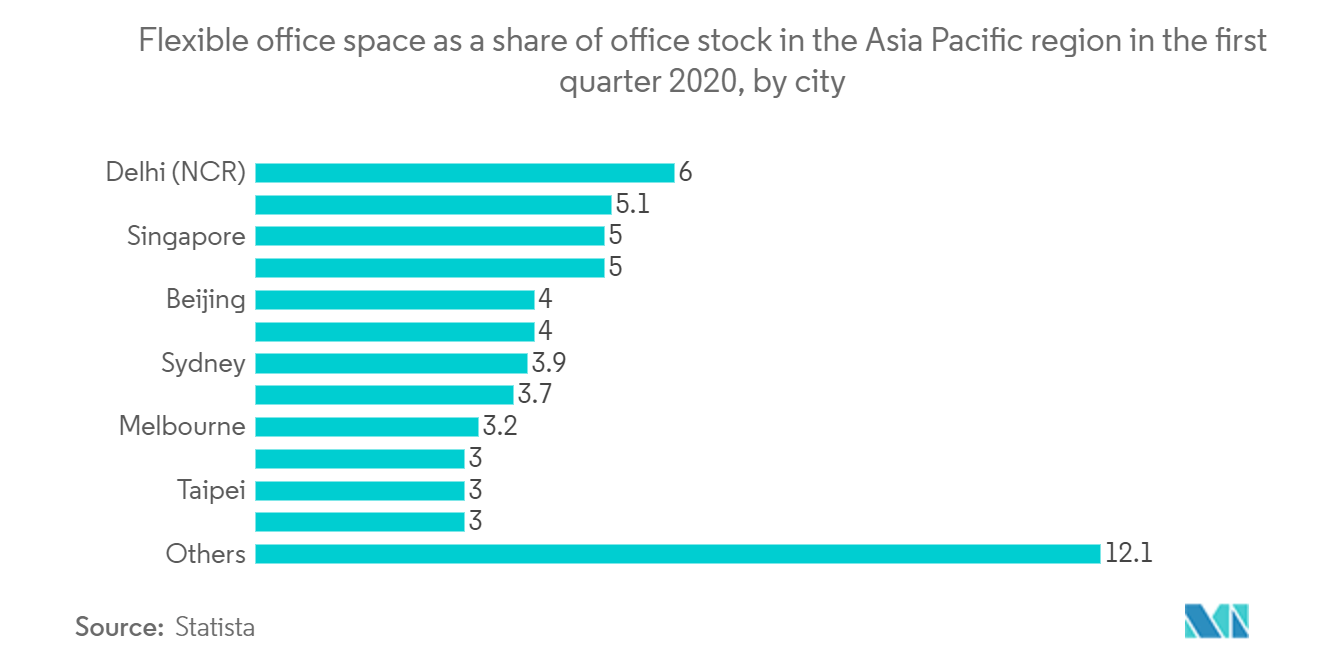APAC Flexible Office Market Size

| Study Period | 2020 - 2029 |
| Base Year For Estimation | 2023 |
| Forecast Data Period | 2024 - 2029 |
| Historical Data Period | 2020 - 2022 |
| CAGR | 4.00 % |
| Market Concentration | Low |
Major Players.webp)
*Disclaimer: Major Players sorted in no particular order |
APAC Flexible Office Market Analysis
The Asia Pacific Flexible Office Market is anticipated to register a CAGR greater than 4% during the forecast period.
Despite a backdrop of political unrest and uncertainty driven by COVID-19, the Asia-Pacific flexible office market has remained strong over the past 12 months. According to the latest research, the industry is in a good position to benefit as companies across the region adjust their office strategies. Despite its relative immaturity, the APAC flexible workspace market has seen three years of successive growth and is now home to nearly 10,000 centers for flexible workspace. Supply of space, which includes coworking, serviced offices, and space as a service, increased by 19% in 12 months, putting the region on track to outpace more established markets in Europe and the US.
About 60% of the top 20 Asia-Pacific cities saw double-digit growth in flexible office space supply last year. Research shows demand for flexible workspace is returning to pre-COVID-19 levels. In the first quarter of 2020, six percent of all the office stock in Delhi was flexible office space. Comparatively, two percent of all the office stock in both Auckland and Guangzhou was flexible office space in the first quarter of 2020. Although the growth of flexible office space has slowed in recent years, it is now firmly established as a strategic long-term real estate solution for a wide range of office occupying industries. The future offices intend to increase their use of flexible space in the coming years.
APAC Flexible Office Market Trends
This section covers the major market trends shaping the APAC Flexible Office Market according to our research experts:
Increase in number of startups in APAC region
Start-ups have been commonly associated with the move towards the adoption of more flexible workspace but of equal importance is the expansion into new markets and accommodating project-based teams. 'Scale-ups' are another type of organisation who have been adopting flex space, allowing greater agility, lower risk, and more flexibility to add additional desks when required. From a sector perspective, enquiries come from Financial, Technology, Consulting and Professional service companies in equal measure with their sizes and requirements also highly varied. New Delhi proved to be the city that exhibited the largest growth in the number of coworking centers not just throughout the Asia Pacific region but globally because of the huge rise in the number of startups and small scale comanies emerging in the city. The Asia-Pacific countries have begun to showcase their business style with an increasing number of successful new businesses. In recent years, one of the most successful new companies in China was the startup Ant Financial now known as Ant Group. China has by far the greatest number of unicorns, followed by India and these are one of the leading countries for the flexible office spaces market in the APAC region.

Hybrid co-working working model taking pace in APAC
The total volume of flexible office space in the Asia Pacific reached 74 million sq. ft. as of October 2020, accounting for more than 4% of total regional office stock, according to the latest industry data. The Asia-Pacific region (APAC) has stood out in the coworking market - it is currently, the largest coworking market in the world. As per industry reports, it is noted that around 300 co-working spaces are located in Asia Pacific gateway cities including Hong Kong, Singapore, Shanghai, Tokyo, Sydney, and Melbourne. In Singapore, coworking spaces have tripled since 2015. Shared working space is projected to increase from 10% to 15% of the total office supply by 2030.
Many Southeast Asian cities such as Kuala Lumpur and Jakarta are also notedly home to a generous host of diverse and extremely price-competitive coworking spaces. Hong Kong, another Asian economic powerhouse, has about 166 coworking spaces, closely rivaling the number of coworking spaces in London and New York City. Both Asian cities have been noted to be some of the fast-growing markets for flexible workspaces, albeit the short-term deceleration of growth due to pandemic.

APAC Flexible Office Industry Overview
The Asia Pacific flexible office spaces market is highly competitive with the presence of many regional players. Many tech startups and unicorns emerging in the APAC region are adopting a hybrid working model and for better collaboration are looking towards flexible office spaces. The silicon valley of India i.e. Bengaluru is seeing a high increase in the number of co-working spaces. Although the number was affected due to COVID, the market is expected to rise soon enough.
APAC Flexible Office Market Leaders
-
The Hive
-
JustCo
-
The Work Project
-
The Great Room
-
Garage Society
*Disclaimer: Major Players sorted in no particular order
.webp)
APAC Flexible Office Market News
October 2021: Compass Offices launches 4 projects in Sheung Wan, Admiralty, and Causeway Bay to cater to the increased demand for flexible office space in Hong Kong. These expansions will present the market with close to 55,000 square feet of flexible office space in prime business districts of Hong Kong.
April 2022 - Leading workspace provider The Work Project (TWP) announced that it will manage 46,268 sq ft of flexible workspace in an upcoming commercial building in Sydney, Australia. The development is called Quay Quarter Tower and it is jointly owned by AMP Capital Wholesale Office Fund and Dexus Wholesale Property Fund.
APAC Flexible Office Market Report - Table of Contents
1. INTRODUCTION
- 1.1 Study Deliverables
- 1.2 Study Assumptions
- 1.3 Scope of the Study
2. RESEARCH METHODOLOGY
- 2.1 Analysis Methodology
- 2.2 Research Phases
3. EXECUTIVE SUMMARY
4. MARKET INSIGHTS
- 4.1 Current Market Scenario
- 4.2 Government Regulations and Initiatives
- 4.3 Technological Trends
- 4.4 Insights on Flexible Office Spaces Rent
- 4.5 Insights on co-working startups in APAC region
- 4.6 Insights on Office Space Planning
- 4.7 Impact of COVID-19 on APAC flexible office space market
5. MARKET DYNAMICS
- 5.1 Market Drivers
- 5.2 Market Restraints
- 5.3 Market Opportunities
- 5.4 Porter's Five Forces Analysis
- 5.5 Industry Value Chain/Supply Chain Analysis
6. MARKET SEGMENTATION
-
6.1 By Offering
- 6.1.1 Private Offices
- 6.1.2 Co-Working Spaces
- 6.1.3 Virtual Offices
-
6.2 By Vertical
- 6.2.1 IT and Telecommunications
- 6.2.2 Media and Entertainment
- 6.2.3 Retail and Consumer Goods
- 6.2.4 Others
-
6.3 By Country
- 6.3.1 China
- 6.3.2 India
- 6.3.3 South Korea
- 6.3.4 Rest of Asia-Pacific
7. COMPETITIVE LANDSCAPE
- 7.1 Overview (Market Concentration Analysis and Major Player)
-
7.2 Company Profiles
- 7.2.1 The Hive
- 7.2.2 JustCo
- 7.2.3 The Work Project
- 7.2.4 The Great Room
- 7.2.5 Garage Society
- 7.2.6 Compass Offices
- 7.2.7 The Executive Center
- 7.2.8 WeWork
- 7.2.9 Regus Corporation
- 7.2.10 Simpliwork*
- *List Not Exhaustive
8. FUTURE OF THE MARKET
9. APPENDIX
** Subject To AvailablityAPAC Flexible Office Industry Segmentation
Flexible workspace is also known as shared office space or flexispace. This type of office space is fitted with basic equipment, like phone lines, desks, and chairs, a setup that allows employees who normally work from home or telecommute to have a physical office for a few hours every week or every month.
Asia Pacific flexible officemarket report covers complete background analysis of the flexible workspaces, leased spaces spaces and co-working spaces market in different segments such as private offices and co-working spaces, which includes an assessment of the sector and contribution of the sector in the economy, market overview, market size estimation for key segments, key countries, and emerging trends in the market segments, market dynamics, and key events statistics. The report also covers the impact of COVID -19 on the market.
Asia Pacific Flexible office market is segmented By Offering (Private Offices Co-Working Spaces Virtual Offices), By Vertical (IT and Telecommunications, Media and Entertainment, Retail and Consumer Goods, and Others) and By Country (China, India, South Korea, and Rest of Asia-Pacific). The report offers market size and forecasts for the market in value (USD billion) for all the above segments.
| By Offering | Private Offices |
| Co-Working Spaces | |
| Virtual Offices | |
| By Vertical | IT and Telecommunications |
| Media and Entertainment | |
| Retail and Consumer Goods | |
| Others | |
| By Country | China |
| India | |
| South Korea | |
| Rest of Asia-Pacific |
APAC Flexible Office Market Research FAQs
What is the current Asia Pacific Flexible Office Market size?
The Asia Pacific Flexible Office Market is projected to register a CAGR of greater than 4% during the forecast period (2024-2029)
Who are the key players in Asia Pacific Flexible Office Market?
The Hive, JustCo, The Work Project, The Great Room and Garage Society are the major companies operating in the Asia Pacific Flexible Office Market.
What years does this Asia Pacific Flexible Office Market cover?
The report covers the Asia Pacific Flexible Office Market historical market size for years: 2020, 2021, 2022 and 2023. The report also forecasts the Asia Pacific Flexible Office Market size for years: 2024, 2025, 2026, 2027, 2028 and 2029.
Asia Pacific Flexible Office Industry Report
Statistics for the 2024 Asia Pacific Flexible Office market share, size and revenue growth rate, created by Mordor Intelligence™ Industry Reports. Asia Pacific Flexible Office analysis includes a market forecast outlook to 2029 and historical overview. Get a sample of this industry analysis as a free report PDF download.



